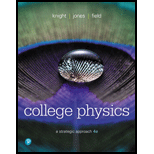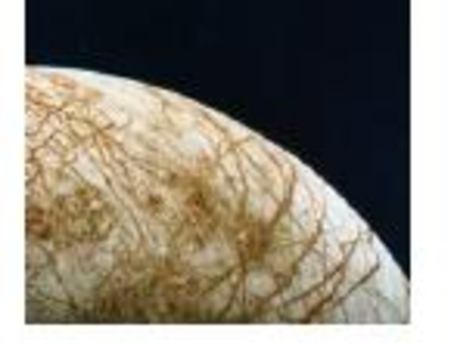Problem 1CQ: A cyclist goes around a level, circular track at constant speed. Do you agree or disagree with the... Problem 2CQ: In uniform circular motion, which of the following quantities are constant: speed, instantaneous... Problem 3CQ Problem 4CQ Problem 5CQ: Large birds like pheasants often walk short distances. Small birds like chickadees never walk. They... Problem 6CQ: When you drive fast on the highway with muddy tires, you can hear the mud flying off the tires into... Problem 7CQ: A ball on a string moves in a vertical circle as in Figure Q6.7. When the ball is at its lowest... Problem 8CQ: Give an everyday example of circular motion for which the centripetal acceleration is mostly or... Problem 9CQ: Give an everyday example of circular motion for which the centripetal acceleration is mostly or... Problem 10CQ Problem 11CQ: A car coasts at a constant speed over a circular hill. Which of the free-body diagrams in Figure... Problem 12CQ: In Figure Q6.11, at the instant shown, is the apparent weight of the cars driver greater than, less... Problem 13CQ: Riding in the back of a pickup truck can be very dangerous. If the truck turns suddenly, the riders... Problem 14CQ: Playground swings move through an arc of a circle. When you are on a swing, and at the lowest point... Problem 15CQ: Variation in your apparent weight is desirable when you ride a roller coaster; it makes the ride... Problem 16CQ Problem 17CQ: Why is it impossible for an astronaut inside an orbiting space station to go from one end to the... Problem 18CQ: If every object in the universe feels an attractive gravitational force due to every other object,... Problem 19CQ: A mountain climbers weight is slightly less on the top of a tall mountain than at the base, though... Problem 20CQ Problem 21MCQ: A ball on a string moves around a complete circle, once a second, on a frictionless, horizontal... Problem 22MCQ: As seen from above, a car rounds the curved path shown in Figure Q6.22 at a constant speed. Which... Problem 23MCQ: As we saw in the chapter, wings on race cars push them into the track. The increased normal force... Problem 24MCQ Problem 25MCQ Problem 26MCQ: The cylindrical space station in Figure Q6.25, 200 m in diameter, rotates in order to provide... Problem 27MCQ: The radius of Jupiter is 11 times that of earth, and the free-fall acceleration near its surface is... Problem 28MCQ: A newly discovered planet has twice the mass and three times the radius of the earth. What is the... Problem 29MCQ: Suppose one night the radius of the earth doubled but its mass stayed the same. What would be an... Problem 30MCQ: Currently, the moon goes around the earth once every 27.3 days. If the moon could be brought into a... Problem 31MCQ: Two planets orbit a star. You can ignore the gravitational interactions between the planets. Planet... Problem 1P: A 5.0-m-diameter merry-go-round is turning with a 4.0 s period. What is the speed of a child on the... Problem 2P Problem 3P: An old-fashioned LP record rotates at 3313rpm. a. What is its frequency, in rev/s? b. What is its... Problem 4P: A typical hard disk in a computer spins at 5400 rpm. a. What is the frequency, in rev/s? b. What is... Problem 5P Problem 6P: The horse on a carousel is 4.0 m from the central axis. a. If the carousel rotates at 0.10 rev/s.... Problem 7P: The radius of the earths very nearly circular orbit around the sun is 1.50 1011 m. Find the... Problem 8P: Modern wind turbines are larger than they appear, and despite their apparently lazy motion, the... Problem 9P Problem 10P Problem 11P Problem 12P: A typical running track is an oval with 74-m-diameter half circles at each end. A runner going once... Problem 13P: Figure P6.13 is a birds-eye view of particles on a string moving in horizontal circles on a... Problem 14P: In short-track speed skating, the track has straight sections and semicircles 16 m in diameter.... Problem 15P Problem 16P: A cyclist is rounding a 20-m-radius curve at 12 m/s. What is the minimum possible coefficient of... Problem 17P: A 1500 kg car drives around a flat 200-m-diameter circular track at 25 m/s. What are the magnitude... Problem 18P: A fast pitch softball player does a windmill pitch, illustrated in Figure P6.18. moving her hand... Problem 19P Problem 20P: A wind turbine has 12,000 kg blades that are 38 m long. The blades spin at 22 rpm. If we model a... Problem 21P: Youre driving your pickup truck around a curve with a radius of 20 m. A box in the back of the truck... Problem 22P Problem 23P: Gibbons, small Asian apes, move by brachiation, swinging below a handhold to move forward to the... Problem 24P: The passengers in a roller coaster car feel 50% heavier than their true weight as the car goes... Problem 25P Problem 26P: A roller coaster car is going over the top of a 15-m-radius circular rise. At the top of the hill,... Problem 27P: As a roller coaster car crosses the top of a 40-m-diameter loop-the-loop, its apparent weight is the... Problem 28P Problem 29P Problem 30P Problem 31P Problem 32P: A satellite orbiting the moon very near the surface has a period of 110 min. Use this information,... Problem 33P: Spacecraft have been sent to Mars in recent years. Mars is smaller than Earth and has... Problem 34P: The centers of a 10 kg lead ball and a 100 g lead ball are separated by 10 cm. a. What gravitational... Problem 35P: The gravitational force of a star on an orbiting planet 1 is F1. Planet 2, which is twice as massive... Problem 36P: The free-fall acceleration at the surface of planet 1 is 20 m/s2. The radius and the mass of planet... Problem 37P: What is the ratio of the suns gravitational force on you to the earths gravitational force on you? Problem 38P Problem 39P: In recent years, astronomers have found planets orbiting nearby stars that are quite different from... Problem 40P Problem 41P: a. What is the gravitational force of the sun on the earth? b. What is the gravitational force of... Problem 42P: What is the value of g on the surface of Saturn? Explain how such a low value is possible given... Problem 43P: What is the free-fall acceleration at the surface of (a) Mars and (b) Jupiter? Problem 44P Problem 45P Problem 46P Problem 47P Problem 48P: Planet X orbits the star Omega with a year that is 200 earth days long. Planet Y circles Omega at... Problem 49P: The International Space Station is in a 250-mile-high orbit. What are the stations orbital period,... Problem 50P: An earth satellite moves in a circular orbit at a speed of 5500 m/s. What is its orbital period? Problem 51P: In recent years, scientists have discovered hundreds of planets orbiting other stars. Some of these... Problem 52P: In recent years, scientists have discovered hundreds of planets orbiting other stars. Some of these... Problem 53P: In recent years, scientists have discovered hundreds of planets orbiting other stars. Some of these... Problem 54GP: How fast must a plane fly along the earths equator so that the sun stands still relative to the... Problem 55GP Problem 56GP: A 75 kg man weighs himself at the north pole and at the equator. Which scale reading is higher? By... Problem 57GP Problem 58GP Problem 60GP Problem 61GP Problem 62GP Problem 63GP Problem 64GP Problem 65GP: A 5.0 g coin is placed 15 cm from the center of a turntable. The coin has static and kinetic... Problem 66GP: In an old-fashioned amusement park ride, passengers stand inside a 3.0-m-tall, 5.0-m-diameter hollow... Problem 67GP: The 0.20 kg puck on the frictionless, horizontal table in Figure P6.59 is connected by a string... Problem 68GP: While at the county fair, you decide to ride the Ferris wheel. Having eaten too many candy apples... Problem 69GP: A car drives over the top of a hill that has a radius of 50 m. What maximum speed can the car have... Problem 70GP: The ultracentrifuge is an important tool for separating and analyzing proteins in biological... Problem 71GP: A sensitive gravimeter at a mountain observatory finds that the free-fall acceleration is 0.0075... Problem 72GP Problem 73GP: Planet Z is 10,000 km in diameter. The free-fall acceleration on Planet Z is 8.0 m/s2 a. What is the... Problem 74GP: How long will it take a rock dropped from 2.0 m above the surface of Mars to reach the ground? Problem 75GP: A 20 kg sphere is at the origin and a 10 kg sphere is at (x, y) = (20 cm, 0 cm). At what point or... Problem 76GP: a. At what height above the earth is the free-fall acceleration 10% of its value at the surface? b.... Problem 77GP: Mars has a small moon, Phobos, that orbits with a period of 7 h 39 min. The radius of Phobos orbit... Problem 78GP: You are the science officer on a visit to a distant solar system. Prior to landing on a planet you... Problem 79GP: Europa, a satellite of Jupiter, is believed to have a liquid ocean of water (with a possibility of... Problem 80MSPP: The direction of the net force on the craft is A. Away from the surface of the moon. B. In the... Problem 81MSPP: Suppose a spacecraft orbits the moon in a very low, circular orbit, just a few hundred meters above... Problem 82MSPP: How much time does it take for the spacecraft to complete one orbit? A. 38 min B. 76 min C. 110 min... Problem 83MSPP: The material that comprises the side of the moon facing the earth is actually slightly more dense... format_list_bulleted



 Principles of Physics: A Calculus-Based TextPhysicsISBN:9781133104261Author:Raymond A. Serway, John W. JewettPublisher:Cengage Learning
Principles of Physics: A Calculus-Based TextPhysicsISBN:9781133104261Author:Raymond A. Serway, John W. JewettPublisher:Cengage Learning